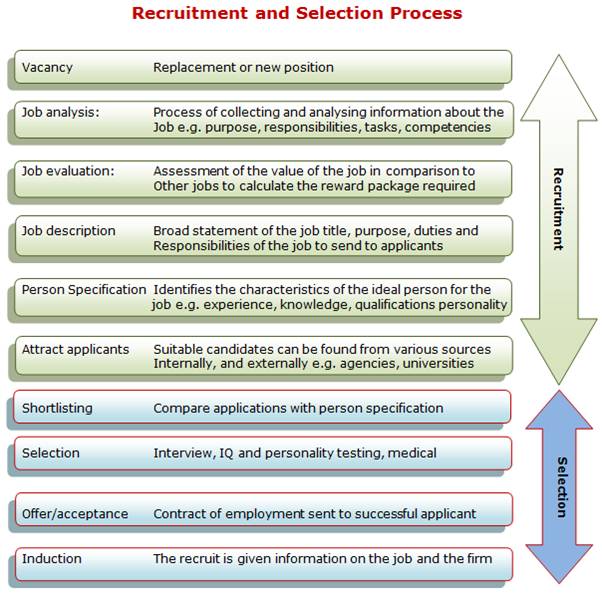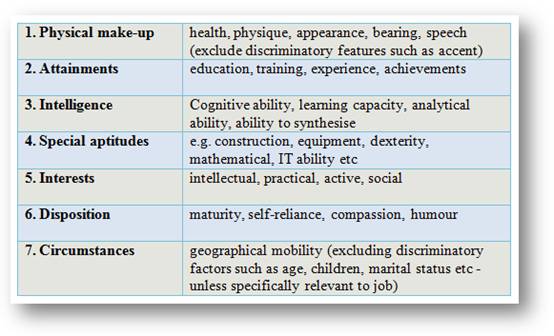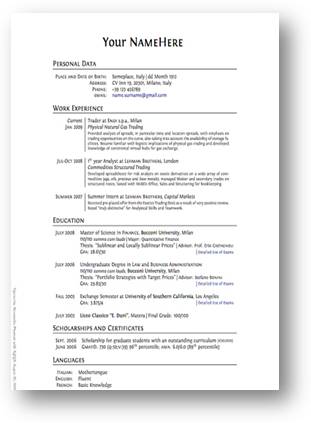Recruitment and selection
We have already noted the importance of getting the right people in the right place at the right time to the ability of a business to meet its strategic plans. To get the correct people and skills a business needs to:
- Determine human resource requirements
- Attract suitable candidates for the vacancies
- Select the most suitable applicants
- Train and develop those who come to work for the business

Recruitment

Recruitment
Recruitment refers to the process of attracting, screening, and selecting qualified people for a job vacancy job in an organisation.
Vacancies occur for a number of reasons:
- An individual leaves the firm to join another organisation
- An individual retires
- An individual is promoted
- New products or technologies require an employee with new skills
- Growth of the firm
Having established the nature and reason for a vacancy, the firm will:
- Draw up a job analysis detailing the specific nature of the responsibilities, tasks, duties, accountability, competencies and training required for that post. This will provide the foundations for the recruitment process
- Prepare a job evaluation which is an assessment of the value of the job in relation to other jobs, so that the rewards and remuneration can reflect its value and attract appropriate candidates.
- Develop a job description, which is a broad description of the job, its title, purpose, tasks, authority and performance targets.
- Prepare a personnel profile (or job/person specification), which defines the individual qualities of the individual needed e.g. qualifications, experience, personality, skills. These can be classified in a number of ways, such as 'essential' and 'desirable' and can be used to create a short list of applicants and as a checklist by the interviewers.
Many organisations base their person specification on the Rodgers seven-point plan:

- Decide on the best way of obtaining the right person. This might be by external recruitment, or internal by redeploying an existing employee, or by replacing the function with a machine or by outsourcing to another company.
- Decide on the route for attracting qualified applicants by selecting the appropriate media for advertising the vacancy, such as local or national paper, radio, notice board, employment agency. This will vary according to the perceived importance of the vacancy.

- Decide on the interview and selection procedure appropriate for the position.
- Decide on any testing and review procedures.
- Make certain all the relevant legal obligations have been met e.g. discrimination acts, holiday entitlements and so on. It is not acceptable in many countries, for example, to state a preference for male or female, unless something specific about the vacancy requires a particular gender.
Once a vacancy is advertised, the firm will need to specify the nature and accepted method of the application. This usually consists of a combination of the following:
-
Application form - this is a standardised form that focuses on information the firm sees as relevant. It can be customised to include details deemed necessary for the specific post or generalised to all applications to the organisation. As all candidates fill in the same details, comparison between them is easier, but the format often restricts candidates from including non standard information or from developing particular areas of strength.
The form should be accompanied by details of the job and clear information about the application and selection procedure. It should:- be realistic and appropriate to the level of the job
- use clear language
- be readable and easily completed
- not request detailed personal information unless relevant to the job
-
 Curriculum vitae (CV) or resume - this is a 'story' of the candidate's life to date. It normally starts with personal details such as address, nationality and gender and then includes information such as educational and professional qualifications, employment history, publications and a career 'vision' A resume tends to be shorter than a CV.
Curriculum vitae (CV) or resume - this is a 'story' of the candidate's life to date. It normally starts with personal details such as address, nationality and gender and then includes information such as educational and professional qualifications, employment history, publications and a career 'vision' A resume tends to be shorter than a CV. - Letter of application - The purpose of a covering letter is to provide a candidate with a less formalised way to introduce themselves, their qualifications and the reasons for their interest in a particular position. Styles can vary according to the nature of the vacancy and the circumstances of the application. It states why the firm should consider the candidate for the post and may develop aspects of the CV.
Selection
The selection process will vary according to the nature and the seniority of the vacant post; the more senior the post, the more formal and potentially lengthy the process. Other factors will influence the nature of the selection process such as location, the size of the business, the resources available, the supply situation in the labour market, the style of management and the corporate culture issues relevant to recruitment and selection.
Once the firm has received completed application forms and/or CVs, the HR team will assess the applicants against the criteria set out in the person specification.
The most common selection process is to:
- Prepare a reduced list, or shortlist, of candidates for interview or some other formal selection procedure. If there are many applications, a long list of candidates may be selected and then this is reduced by initial screening, so the firm is left with a shortlist.
- Call for references from previous employees, educational institutions or from personal connections. These are written statements from individuals who have knowledge of the strengths and weaknesses and comment on candidate skills, aptitudes, personality, motivation and loyalty. As referees are normally selected by the candidate they tend to be positive.
- Invite for interview candidates who have favourable references.
The firm will have in mind their ideal candidate, but must be careful not to break any employment laws related to sexual and racial discrimination in the selection of shortlist.
The Interview
 Interviewing is still the most common form of selection. This may be done by individual managers or by a panel. Candidates may be interviewed just once or go through several stages of interviews with a number of interested parties. Shortlists may be reduced further at each stage and the final interviews may be conducted with only two or three candidates.
Interviewing is still the most common form of selection. This may be done by individual managers or by a panel. Candidates may be interviewed just once or go through several stages of interviews with a number of interested parties. Shortlists may be reduced further at each stage and the final interviews may be conducted with only two or three candidates.
Interviews are designed to provide the applicant and the firm the opportunity to meet and develop their understanding of each other. This should be a two-way process. More information is provided by the firm about the vacancy, the organisation and reward structure and the applicants will have the opportunity to clarify aspects of the job description. The firm will be able to ask more probing questions of the candidate and examine their performance under pressure.
Interviews are better if they are structured and allow every candidate the same opportunities, reducing the possibilities of bias in questions asked. The Rodgers seven-point plan used to draw up the person specification can also be used as a checklist for preparing the questions to be asked.
Research shows that interviewing is not a particularly effective or reliable form of selection. Interviewers may be influenced by a range of personal characteristics that do not necessarily impact on the performance of the job. For example, the accents of the candidates may be falsely linked to negative or positive characteristic as may the attractiveness or otherwise of the interviewee. Consequently, a number of other selection techniques have been developed to support the selection process.
Testing
Interviews are often combined with some of the following activities:
- Achievement tests - tests what the candidate knows and can do.
- Aptitude tests - examine the potential of the candidate to perform specific tasks required by the job e.g. using computer software applications.
- Psychometric tests - assessment of the candidate's personality, attitudes and character to predict whether he or she would fit into a team, respond to the pressures of the job and be prepared to accept or seek responsibility, e.g. is the candidate a team player or loner, extrovert or introvert, passive or assertive? These are more often applied to senior posts.
- Intelligence tests - whether the candidate has the mental abilities required for the job, such as literacy and numeracy skills.
- Group situational tests - observation of candidates performing tasks as members of a team.
Assessment centres
These centres are designed to test the performance of candidates over a prolonged time period. Candidates are put through a range of tests, exercises, interviews, group activities and role plays often lasting several days. Research shows that this is an effective way to get close to recreating the demands of a job and, therefore selecting the appropriate person. However, this assessment is time consuming and expensive as it involves a team of recruiters. Therefore, it is usually restricted to more senior posts.
Contract of employment
At the end of the selection process, the successful candidate is offered a contract of employment. This may be subject to a successful medical. The terms and conditions laid out in the contract usually cover the following:
- Job title
- Date of commencement
- Job role and specification
- Hours of work
- Remuneration e.g. pay and bonus entitlement
- Holiday and sick pay entitlement
- Pension scheme and entitlements
- Disciplinary procedures
- Grievance procedures
- Notice requirements from both sides - employer and employee
- Signatures of both parties
Induction
A good induction period should minimise the disruption caused by a new arrival. The process is designed to introduce new employee into the organisation, by outlining aspects like the history, mission, vision and the culture of the business, more specific information about the nature and responsibilities of the job including health and safety issues and to find out practical aspects of the business e.g. location of photocopies, restrooms, dining facilities etc.
The inductee will meet colleagues and other new employees and it is likely to have some social occasions built in. New employees may be allocated a support mentor for the first few weeks.
Staff may also be supplied with vehicles, uniforms and equipment during induction and contracts of employment may be finalised.
Internal and external recruitment
There are two ways in which an organisation can update its skills base and fill employment gaps by:
- recruiting from existing workforce pool by redeployment or promotion, or
- by adding to the existing pool by bringing in 'new blood'.
Both methods have their advantages and disadvantages, and so it is common for organisations to employ a combination of the two.
Internal recruitment or development
Internal recruitment means that a job vacancy is filled from within the business by promoting, re-skilling or redeploying an existing employee rather than employing externally. This route will be selected if the business decides they already have the right people with the right skills to do the job.
Advantages
- Knowledge of the strengths and weaknesses of the employee
- Uses in-house resources and builds on skills and expertise of existing staff
- Retains valuable employees and avoids recruitment costs while ensuring a return on any investment in training and development
- By providing opportunities for development and promotion for existing staff, motivation in the organisation may be improved
- A shorter induction period as the employee already knows and understands the business
- Cost-effective - it is generally quicker and cheaper
Disadvantages
- Limited number of applicants
- External candidates might be better suited or qualified for the job
- Creates another vacancy
- The organisation may become resistant to change
- Fewer ideas brought into the organisation and innovative solutions lost
- Internal recruitment methods can restrict the pool to people who are culturally similar to, or reflect the personal preferences of, current employees
- Internal factions may support different candidates and cause conflict
- May cause discontent amongst those overlooked for promotion
This internal route might take longer to deliver the expected results, as personnel will have to be selected, trained and tested. However, this need not be a deterrent. Discovering exactly what is wanted and developing the individual or individuals to the required level of understanding will ensure that what is created will be as the company wanted.

Some organisations offer incentives to existing employees to assist in the recruitment of family or friends. Richer Sounds, a UK electronics retailer aims to recruit internally whenever it can and offers existing staff a bonus to recruit 'people like us'. For more information how selection is conducted visit the Richer Sounds Student Zone .
Internal recruitment can be effective when nurturing employees into senior position and can reduce recruitment costs. However, this is not a very diverse method of recruitment and the firm risk losing out on interesting and innovative perspectives from external candidates.
 External recruitment
External recruitment
This is when a company accepts that it is lacking in a certain range of skills and attempts to rectify this by advertising for a new employee with the abilities they need. By bringing in this 'new blood' it is hoped that the stock of talents held within the company will improve and that a transfer of skills will begin. That is, the new employee will implant some of their skills in existing employees. As such any competitor advantage should be addressed. The company hopes that by increasing its stock of talents it will regain any losses in its competitive advantage and be able to provide customers with what they expect.
Recruitment may be from a specialist source or by adverts placed in relevant publications. Someone might even be 'poached' from a rival who appears to have an advantage in that its skills base is more developed (this is often called 'headhunting'). The latter would, of course, have several advantages to the company acquiring the new employee.
Advantages
- Greater choice and experience
- Avoids the risk of creating resentment by promoting 'favourites' from the inside
- Outsiders bring in fresh ideas, skills and knowledge
- Forces internal staff to 'compete' and update their skills, education, etc
- Helps to facilitate change in culture
- New blood' and a more dynamic workforce
- Easier because of the internet
Disadvantages
- New appointee may not fit the existing culture within the organisation
- May affect the morale of internal staff who have been overlooked
- Require a longer period of induction and orientation
- Time consuming and, therefore, expensive
- May take longer to fill the vacancy
- May create resentment from existing employees not considered by the firm
- Greater risk of making a mistake and employing an unsuitable person
Many organisations seek to fill a vacant position internally in the first instance, and then follow through with an external campaign if no suitable inside staff are identified. To avoid resentment among existing staff, the organisation must be clear and consistent in communicating the corporate recruitment policy as it relates to sourcing suitable staff.
The major disadvantage in an external job search campaign is that it can be time consuming and costly.